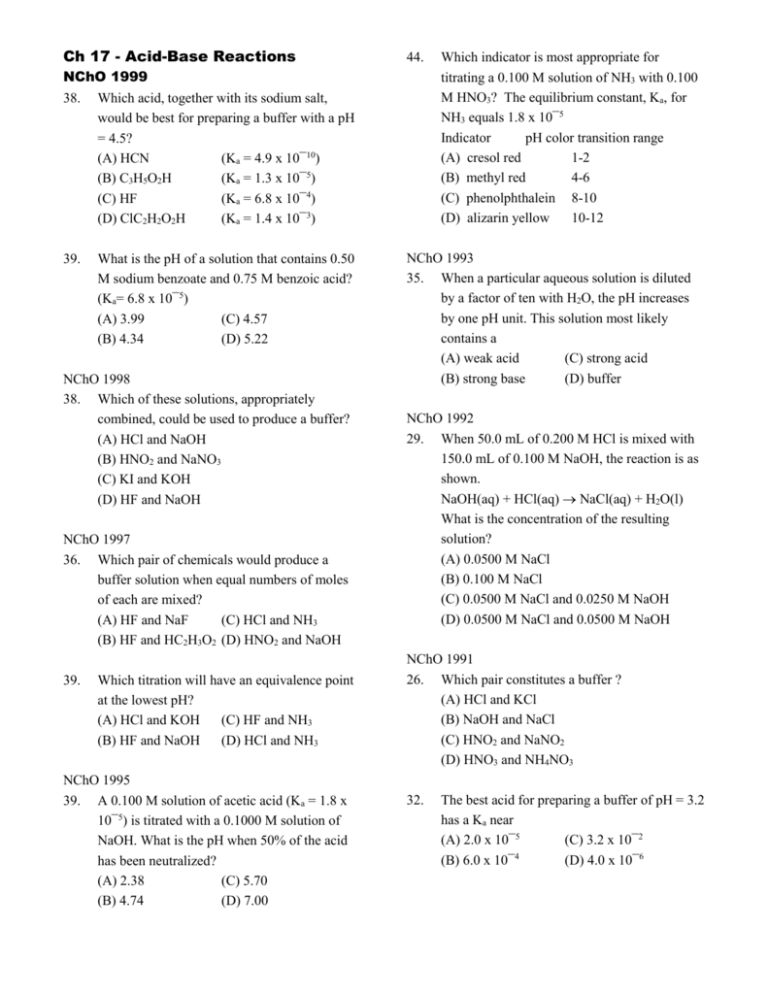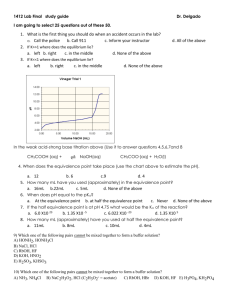titrations problems with answers
advertisement

Ch 17 - Acid-Base Reactions 44. NChO 1999 38. Which acid, together with its sodium salt, would be best for preparing a buffer with a pH = 4.5? (A) HCN (Ka = 4.9 x 10¯10) (B) C3H5O2H (Ka = 1.3 x 10¯5) (C) HF (Ka = 6.8 x 10¯4) (D) ClC2H2O2H (Ka = 1.4 x 10¯3) 39. What is the pH of a solution that contains 0.50 M sodium benzoate and 0.75 M benzoic acid? (Ka= 6.8 x 10¯5) (A) 3.99 (C) 4.57 (B) 4.34 (D) 5.22 NChO 1998 38. Which of these solutions, appropriately combined, could be used to produce a buffer? (A) HCl and NaOH (B) HNO2 and NaNO3 (C) KI and KOH (D) HF and NaOH NChO 1997 36. Which pair of chemicals would produce a buffer solution when equal numbers of moles of each are mixed? (A) HF and NaF (C) HCl and NH3 (B) HF and HC2H3O2 (D) HNO2 and NaOH 39. Which titration will have an equivalence point at the lowest pH? (A) HCl and KOH (C) HF and NH3 (B) HF and NaOH (D) HCl and NH3 NChO 1995 39. A 0.100 M solution of acetic acid (Ka = 1.8 x 10¯5) is titrated with a 0.1000 M solution of NaOH. What is the pH when 50% of the acid has been neutralized? (A) 2.38 (C) 5.70 (B) 4.74 (D) 7.00 Which indicator is most appropriate for titrating a 0.100 M solution of NH3 with 0.100 M HNO3? The equilibrium constant, Ka, for NH3 equals 1.8 x 10¯5 Indicator pH color transition range (A) cresol red 1-2 (B) methyl red 4-6 (C) phenolphthalein 8-10 (D) alizarin yellow 10-12 NChO 1993 35. When a particular aqueous solution is diluted by a factor of ten with H2O, the pH increases by one pH unit. This solution most likely contains a (A) weak acid (C) strong acid (B) strong base (D) buffer NChO 1992 29. When 50.0 mL of 0.200 M HCl is mixed with 150.0 mL of 0.100 M NaOH, the reaction is as shown. NaOH(aq) + HCl(aq) NaCl(aq) + H2O(l) What is the concentration of the resulting solution? (A) 0.0500 M NaCl (B) 0.100 M NaCl (C) 0.0500 M NaCl and 0.0250 M NaOH (D) 0.0500 M NaCl and 0.0500 M NaOH NChO 1991 26. Which pair constitutes a buffer ? (A) HCl and KCl (B) NaOH and NaCl (C) HNO2 and NaNO2 (D) HNO3 and NH4NO3 32. The best acid for preparing a buffer of pH = 3.2 has a Ka near (A) 2.0 x 10¯5 (C) 3.2 x 10¯2 (B) 6.0 x 10¯4 (D) 4.0 x 10¯6 Ch 17 - Acid-Base Reactions Annotated Answers: 1999-38. (B) C3H5O2H – The best buffer has a pH = pKa of the acid. HCN pKa = 9.31; C3H5O2H pKa = 4.89; HF pKa = 3.17; ClC2H2O2H pKa = 2.85 1999-39 (A) 3.99 Note: benzoate ion is the conjugate base of the acid, benzoic acid.,, just like nitrate ion is the conjugate base of the acid, nitric acid. If the buffer was 50:50 Acid:Conjugate Base, the pH = pKa = 4.17 You have more of the acid, so the pH will be lower. The only answer less than 4.17 is 3.99. 1998-38. (D) HF and NaOH (A) HCl & NaOH strong acid & strong base will never make a buffer. (B) HNO2 & NaNO3 this could work if the salt were NaNO2. (C) KI and KOH a salt and a strong base… no buffer here (D) This will form a buffer if you have half as much NaOH as HF. When you neutralize HF with NaOH, you form F-, the conjugate base of HF. (A) HF and NaF – classic weak acid (HF) and its conjugate base (F-) Notice the question states “equal numbers of moles of each”. (B) HF and HC2H3O2 -- two weak acids (C) HCl and NH3 -- this would make a buffer if you had half as much HCl as NH3. See above. (D) HNO2 and NaOH – this would work if you had half as much NaOH as HNO2. 1997-36. 1997-39. (D) HCl and NH3 Notice: “Lowest pH = most acidic” Look for a strong acid titrated with a weak base. 1995-39. (B) 4.74 When the acid has been 50% titrated, you have a buffer where [HC2H3O2] = [C2H3O2-] and the pH = pKa. -log(1.8 x 10-5) = 4.74 1995-44. (B) methyl red pH color transition range: 4-6 Strong acid + weak base will form an acidic solution at the end point of the titration. A 0.100 M solution of HCl would have a pH of 1.00 A solution of NH4+ will be much closer to 7. The pH CAN be calculated: Equal volumes of HNO3 and NH3 are needed to reach the endpoint. All of the NH3 is converted to NH4+, but the volume is doubled. [NH4+] = 0.100 ÷ 2 = 0.0500 M. The question to answer is: What is the pH of a 0.0500 M solution of NH4+? Ka of NH4+ = Kw/Kb = 5.56 x 10-10 Shortcut: x = [H+] = (0.0500)(5.56 x 10-10) = 5.27 x 10-6 pH = 5.28 1993-35. (C) strong acid This is kind of a logic problem using information you know about acids and pH’s. When you dilute the substance, the pH increases. Is it an acid? 34 or base? 89. But you know that diluting an acid or a base would move it closer to 7, so 34 makes sense. The fact that diluting it 10x changes the pH by 1 means it must be a strong acid. A weak acid only partially dissociates (breaks up). Diluting it would lower the [H+], but by 10x. 1992-29. (C) 0.0500 M NaCl and 0.0250 M NaOH First, remember that volume x molarity = moles. You have 0.0100 moles HCl and 0.150 moles NaOH . All of the HCl gets used up and 0.0100 moles of NaCl is formed. Divide these moles by the total volume (200 mL or 0.200 L) to get the answer. I did this with an ICE box. 1991-26. (C) HNO2 and NaNO2 Classic buffer. Weak acid (HNO2) and its conjugate base (NO2-). Remember, Na+ is a spectator ion. (A) HCl and KCl – strong acid and its conjugate base. This is not a buffer (B) NaOH and NaCl -- strong base and its conjugate acid. This is not a buffer (D) HNO3 and NH4NO3 -- strong acid and the conjugate acid of NH3. This is not a buffer. 1991-32. (B) 6.0 x 10-4 The pH of a buffer is the pKa of the acid. Ka = 10-pKa A Ka with “x 10-4” will result in a pKa near 3.2.









